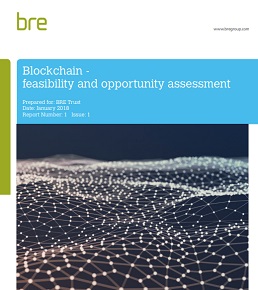Blockchain – feasibility and opportunity assessment
A new report from BRE Trust, published in February 2018, explores opportunities to address challenges in the built environment industry using blockchain technology.
Distributed Ledger Technology (of which blockchain is one application) is a digital record of the economic transactions or changes in the ownership of an asset. The information is shared and continually updated on a network of computers simultaneously, whilst secured through cryptography. This means that while allowing digital information to be distributed, but not copied, a blockchain is both transparent and incorruptible.
The new report, ‘Blockchain – feasibility and opportunity assessment’, draws insights from two workshops run by the BRE Trust in partnership with Constructing Excellence and industry professionals. The issues it covers include:
- The potential for better ‘track and trace’ of products throughout their life cycles, to give a clear picture of where they came from, who supplied them and who installed them.
- The evolution of distributed energy systems to support more localised energy creation and use.
- The use of blockchain technology to help tackle modern slavery and human trafficking by creating more transparency in construction supply chains.
- Connected districts and cities with the Internet of Things – blockchain technology offers a distributed system of registers, all of which are connected through a secure validation mechanism.
Dr Shamir Ghumra, Director of the Centre of Sustainable Products said:
“This report will help inform the current debate on Distributed Ledgers and Blockchains; there are many opportunities and synergies we can explore with this evolving technology for the betterment of the built environment itself but importantly we should see direct benefit and engagement with all parts of the value chain.”
The report presents how blockchain could be applied to a wide range of built environment sectors, but each potential application comes with questions and implications that warrant further investigation.
For example, in an industry that relies heavily on the regulation, certification and verification of products and services, the risk of human error when creating coding raises the question of whether a private or a public blockchain would be more appropriate.
While both act as distributed peer-to-peer networks, private blockchains have organisations or governing bodies retaining control and verifying all users of the system. Artificial intelligence and sensing technologies could also help reduce the human-error risk factor, and provide a means of automatically certifying and verifying application processes.
Also, large public blockchains currently require huge amounts of energy to extract – ‘or mine’ – the information needed to create the blocks – i.e. the records – that are linked to form the chains. With an increased focus on optimum efficiency and sustainability, the built environment industry will need to find new solutions to address this issue. The potential to disrupt and change the way parts of the built environment work and create value is about to take the jump forward, as Mark Farmer, co-Chair of Constructing Excellence said [we need to] “modernise or die”.
The report, ‘Blockchain – feasibility and opportunity assessment’, is available on the BRE Group website.
This article was originally published here on 22nd February 2018 by BRE.
[edit] Related articles on Designing Buildings Wiki
- BRE articles on Designing Buildings Wiki.
- Blockchain could transform the construction industry.
- Blockchain definitions.
- Blockchain technology in the construction industry.
- Blockchains will change construction.
- Construction innovation.
- Eliminating waste at scale – opportunities for blockchain.
- Is disruptive innovation possible in the construction industry?
- Non-fungible token NFT.
- Student projects released as non-fungible tokens.
- Unprecedented innovation and new technologies on the horizon.
Featured articles and news
Infrastructure that connect the physical and digital domains.
Harnessing robotics and AI in challenging environments
The key to nuclear decommissioning and fusion engineering.
BSRIA announces Lisa Ashworth as new CEO
Tasked with furthering BSRIA’s impressive growth ambitions.
Public buildings get half a million energy efficiency boost
£557 million to switch to cleaner heating and save on energy.
CIOB launches pre-election manifesto
Outlining potential future policies for the next government.
Grenfell Tower Inquiry announcement
Phase 2 hearings come to a close and the final report due in September.
Progress from Parts L, F and O: A whitepaper, one year on.
A replicated study to understand the opinion of practitioners.
ECA announces new president 2024
Electrical engineer and business leader Stuart Smith.
A distinct type of countryside that should be celebrated.
Should Part O be extended to existing buildings?
EAC brands heatwave adaptation a missed opportunity.
Definition of Statutory in workplace and facilities management
Established by IWFM, BESA, CIBSE and BSRIA.
Tackling the transition from traditional heating systems
59% lack the necessary information and confidence to switch.
The general election and the construction industry
As PM, Rishi Sunak announces July 4 date for an election.
Eco apprenticeships continue help grow green workforce
A year after being recognised at the King's coronation.
Permitted development rights for agricultural buildings
The changes coming into effect as of May 21, 2024.























